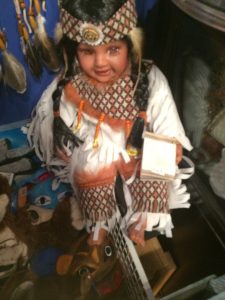Cultural Exploitation in Souvenir Shops

Canada is benevolent, Canada is kind, and Canada embraces and accepts everyone, regardless of age, race, gender, sexuality, ability or culture. Or so, this is how Canada wants to appear to the world. Through Canadian exceptionalism, a national identity based on politeness, kindness, and acceptance has been cultivated, resulting in the horrors of both past and present day being glossed over or completely masked (Howell 2005). However, although its reputation appears to be sparkling and clean, Canada has been far from kind to many groups of people, including the Aboriginal populations of the country, such as through residential schools and discrimination within The Indian Act (indigenousfoundations.arts.ubc.ca). Although some efforts have been made to not only apologize, but to also further support Aboriginal peoples rights, there are areas where vast improvements still need to be made.
In Vancouver, the idea of Canada embracing and taking pride in Aboriginal cultures is threaded throughout tourist attractions, such as on Granville Island. For many people, travel includes bringing home souvenirs to friends and family members (Héroux & Church 2014), so unsurprisingly, souvenir shops are prevalent. With Granville Island being the third ranked tourist attraction in Vancouver (Slattery 2015), there are several stores for people visiting to choose from, in addition to local artisan shops. The picture shown is taken at a shop called The Raven and the Bear Arts, the shop I chose to investigate.
Upon entry, it was obvious that Indigenous culture was the main ‘theme’ of the shop. Several items that were being sold struck me as problematic, such as ‘100% Natural & Tribal & Handmade Bracelets’ with Made in China stickers on them, but the doll shown in the picture stood out to me the most. Although I am unsure of the authenticity of the other products in the store, the doll alone showcases many issues.
At first glance, it is evident that the doll is dressed in a very stereotypical outfit, complete with feathers, fringe, and beading. Oh the tag attached to her, there is the statement, “Our Native American products are not Indian produced or an Indian product as defined by 25 USC-305 et Seq,” a disclaimer to avoid any legality issues (Howland, Lillehoj, & Mayer 2017).
Evidently, there are many problems with this already. First of all, this doll is labeled as Native American, and the company is based in Los Angeles, California, yet it is being sold in a shop in Vancouver, Canada as a way to express Aboriginal culture of presumably Coast Salish peoples. This, in conjunction with the stereotypical outfit of the doll, implies the notion that all Indigenous cultures are the same, regardless of country, nation, band, tribe, or individual (Ross & Lesser 2011). When tourists come to Granville Island and visit shops such as this one, Aboriginal cultures are reduced to inauthentic items that can be bought, and are generalized with other Indigenous peoples, such as those from the United States. Cultural appropriation, exploitation, and commodification are evident here, as the company Kinnex Collection has taken surface-level cultural aspects of Indigenous peoples and created a doll to be bought and sold for profit. The making and selling of a doll as such “entails outsiders appropriating and imitating cultural heritage…in an inauthentic manner [and] limits the economic benefits indigenous groups can gain from products of their culture” (Guttentag 2009, p. 23).
Rather than evidencing the injustices that Indigenous peoples have endured and fought against, Aboriginal peoples are showcased stereotypically and as something to be consumed by tourists who come to Vancouver. Both consumers and companies must be conscious of the issues with buying and producing inauthentic Indigenous products, as it not only takes away from local Indigenous artisans, but contributes to a larger problem surrounding the social differentiation, exploitation, and commodification of Indigenous peoples.
References
Guttentag, D. (2009). The legal protection of indigenous souvenir products. Tourism Recreation Research, 34(1), 23-34. doi:10.1080/02508281.2009.11081572
Howell, A. (2005). Peaceful, tolerant and orderly? A feminist analysis of discourses of ‘Canadian values’ in Canadian Foreign Policy. Canadian Foreign Policy Journal, 12(1), 49-69. doi:10.1080/11926422.2005.9673388
Howland, D., Lillehoj, E., & Mayer, M. (2017). Art by dispossession at El Paso saddleblanket company: Commodification and graduated sovereignty in global capitalism. In Art and sovereignty in global politics (pp. 169-197). New York, NY: Palgrave Macmillan.
Héroux, L., & Church, N. J. (2014). Marketing strategies of gift and souvenir shops in Canada and the United States. OpenEdition, 33(2).
Ross, S. D., & Lester, P. M. (2011). Native American stereotypes. In Images that injure: Pictorial stereotypes in the media (pp. 113-120). Santa Barbara, CA: Praeger.
Slattery, J. (2015, July 28). 11 popular Vancouver tourist attractions ranked. Retrieved from http://www.vancitybuzz.com/2015/07/best-vancouver-tourist-attractions/
UBC Indigenous Foundations website: http://indigenousfoundations.arts.ubc.ca/
